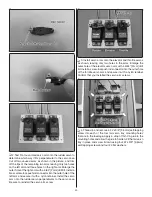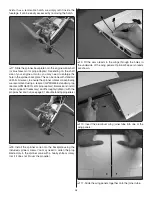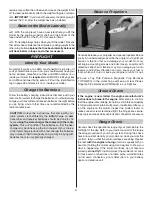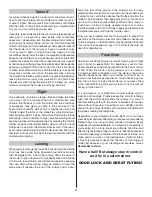
34
Takeoff
It is typical when fl ying with an instructor to allow him or her to
have control during take off and landing for at least your fi rst
couple of fl ights. Allow yourself time to become comfortable
with the sticks in the air before attempting a complete fl ight
on your own if you are a beginning pilot.
If possible, take off directly into the wind. If you are experienced,
taking off in a crosswind is permissible (and sometimes
necessary—depending upon the prevailing wind conditions
and runway heading).Taking off into the wind will help the
model roll straight and also reduces ground speed for takeoff.
Taxi the model onto the runway or have an assistant carry
it out and set it down, pointing down the runway into the
wind. When ready, lower the fl aps (if equipped) and gradually
advance the throttle while simultaneously using the left stick
(rudder/nose wheel) to steer the model. Gain as much speed
as the runway and fl ying site will practically allow before gently
applying up elevator lifting the model into the air. Be ready
to make immediate corrections with the ailerons to keep the
wings level, and be smooth on the elevator stick, allowing
the model to establish a gentle climb to a safe altitude before
making the fi rst turn (away from yourself). Do not “yank” back
the elevator stick forcing the plane into too steep of a climb
which could cause the model to quit fl ying and stall.
Flight
Once airborne, maintain a steady climb and make the initial
turn away from the runway. When at a comfortable, safe
altitude, throttle back to slow the model and raise the fl aps
(if equipped), thus giving you time to think and react. The
Avistar Elite should fl y well at half or slightly less than half
throttle. Adjust the trims so the plane fl ies straight and level.
After fl ying around for a while, and while still at a safe altitude
with plenty of fuel (or battery charge), practice slow fl ight and
execute practice landing approaches by reducing the throttle
further to see how the model handles when coming in to land.
Add power to see how the model climbs as well. Continue to
fl y around while learning how the model responds. Mind your
fuel level, but use this fi rst fl ight to become familiar with the
model before landing.
Landing
When ready to land, gently lower the fl aps and pull the throttle
stick fully back while fl ying downwind just before making
the 180-degree turn toward the runway. Allow the nose of
the model to pitch downward to gradually bleed off altitude.
Continue to lose altitude, but maintain airspeed by keeping
the nose down while turning. Apply up elevator to level the
plane when it reaches the end of the runway and is about
fi ve to ten feet off the ground. If the model is too far away,
carefully add a small amount of power to fl y the model closer.
If going too fast, smoothly advance the throttle and allow the
model to gain airspeed, then apply elevator to climb out and
go around to make another attempt. When fi nally ready to
touch down, continue to apply up elevator, but not so much
that the airplane will climb. Continue to apply up elevator while
the plane descends until it gently touches down.
After you have landed and shut the engine off, adjust the
pushrods on the ailerons, elevator and rudder as necessary
so the trim levers on the transmitter may be returned to center.
This will not be required on any of the controls that did not
need trim adjustments.
Final Note
One fi nal note about fl ying your model. Have a goal or fl ight
plan in mind for
every
fl ight. For beginners, your fi rst few
fl ights should be you becoming familiar with the basic controls
of R/C. When the plane is fl ying toward you it is common
for beginner pilots to hesitate or turn the plane in the wrong
direction because the aileron and rudder control will act in
reverse from the pilot’s perspective as it was when fl ying away
from them. Focus on fl ying the model as if you were sitting
in the cockpit. With practice you will learn to do this without
having to think about it.
As you progress, your fl ight plans should include smooth
takeoffs and landings. Practice executing smooth landings
such that the Avistar approaches the runway in a smooth
and descending path with the correct airspeed and touches
down without bouncing. If possible at your airfi eld, perform
several “touch and go” landings until you are comfortable with
the plane’s landing characteristics.
Regardless of your objective for each fl ight, do not surprise
yourself by impulsively attempting a maneuver and suddenly
fi nding that you’ve run out of time, altitude or airspeed. Every
maneuver should be deliberate, not impulsive. For example, if
you’re going to do a loop, check your altitude, mind the wind
direction (anticipating rudder corrections that will be required
to maintain heading), remember to throttle back at the top, and
make certain you are on the desired rates (high/low rates).
A fl ight plan greatly reduces the chances of crashing your
model just because of poor planning and impulsive moves.
Remember to think.
Have a ball! But always stay in control
and fl y in a safe manner.
GOOD LUCK AND GREAT FLYING!
Содержание Aviastar elite
Страница 35: ...35 This model belongs to Name Address City State Zip Phone Number AMA Number...
Страница 36: ...GPMA1005 Mnl...



































